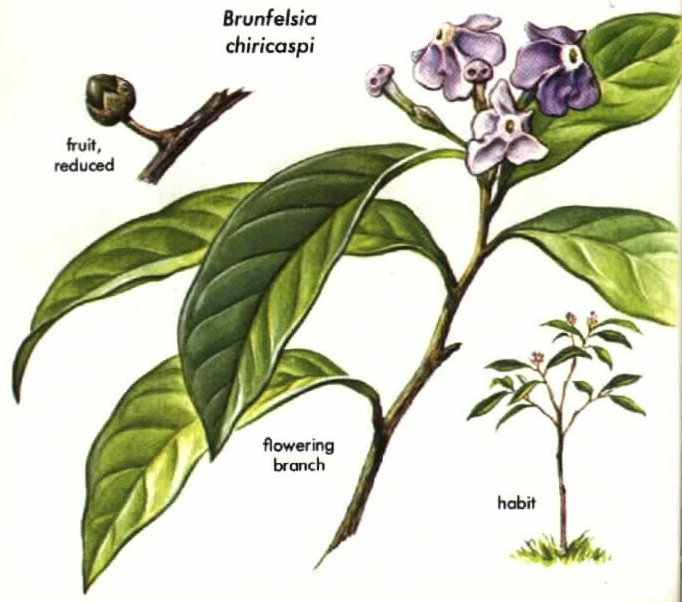Golden Guide: Hallucinogenic Plants
pages 131 to 140
.
Contents...1-10...11-20...21-30...31-40...41-50...51-60...61-70...71-80...81-90
91-100...101-110...111-120...121-130...131-140...141-150...151-156...Index
Indian girl from Oaxaca grinding Ipomoea seeds on a metate.
PRESENT USE of the sacred Mexican morning glory seeds differs little from ancient practices. The seeds are used for divination, prophecy, and diagnosis and treatment of illness by many tribes, especially the Chatinos, Chinantecs, Mazatecs, and Zapotecs. In almost all Oaxacan villages, the seeds serve the Indians "as an ever present help in time of trouble."
The modern ceremony, featuring the use of morning glory seeds to treat an illness, is a curious blending of old Indian beliefs and Christianity.The native who is to be treated collects the seeds himself. About a thimbleful of the seeds--often the magic number is 13-- is measured out. The seeds are ground by a virgin, usually a child, in a special ritual accompanied by complex prayer. Water is added, the resulting beverage is strained, and the patient drinks it at night in silence. After more prayers, he lies down with someone by his side who listens to what he says while intoxicated. This determines the cause of his troubles.
Indian patient drinking potion prepared from Ipomoea seeds.
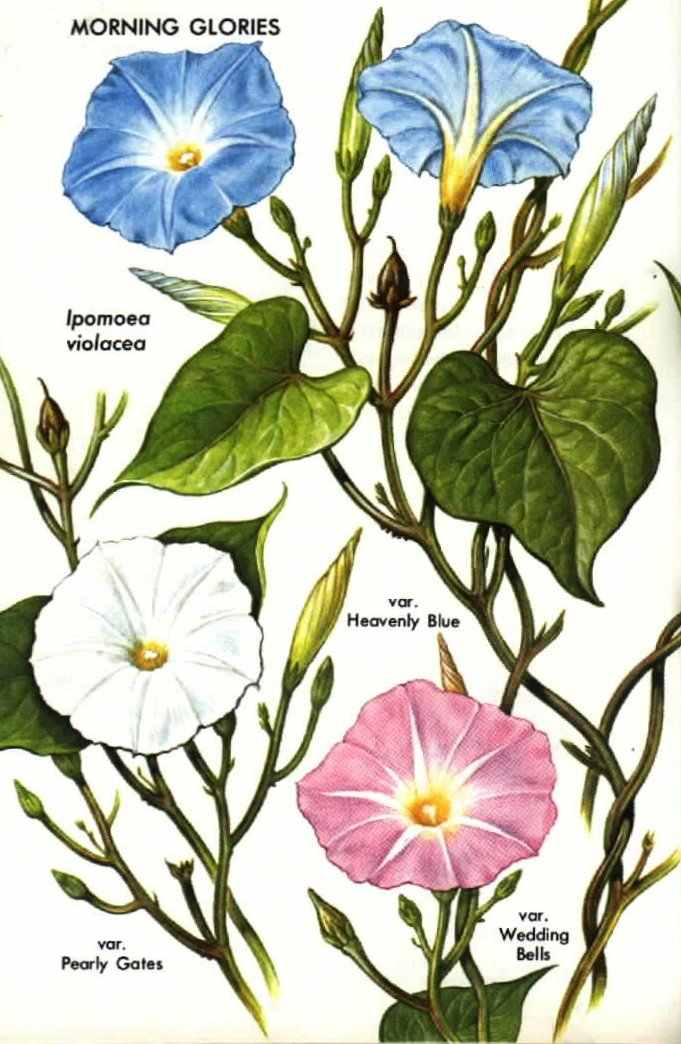
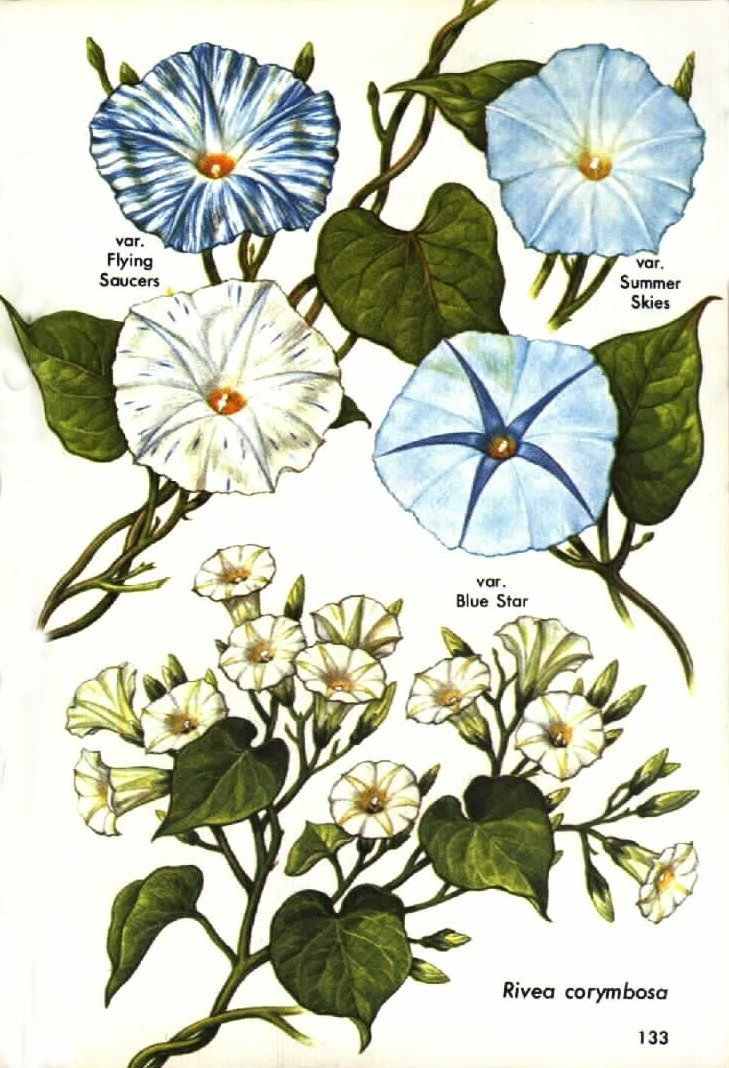
EXPERIMENTAL STUDIES of the narcotic morning glories began in 1955 when a psychiatrist published notes on self-experimentation with Rivea seeds, showing that they brought on an intoxication accompanied by hallucinations. This announcement prompted chemists to examine the plant, but no active principle could be found until the 1960's. At that time the chemist who discovered LSD analyzed the plant and found several alkaloids closely related to that potently hallucinogenic synthetic compound.
His astonishing discovery met with widespread disbelief, partly because these Iysergic-acid derivatives had hitherto been known in nature only in the primitive fungus ergot (Claviceps purpurea), a parasite on the grains of rye in Europe, when ergot was accidentally ground up in a mill with rye flour and eaten in bread made from the flour, it poisoned whole towns, causing a terrible intoxication and leading frequently to widespread insanity and death. In the Middle Ages, before causes were understood and preventative measures taken, these mysterious mass attacks were called St. Anthony's Fire and were attributed to God's wrath.
Half a dozen of these ergoline alkaloids have been found in seeds of Rivea corymbosa and Ipomoea violacea. The main hallucinogenic constituents of both seeds are ergine (d-lysergic acid diethylamide) and isoergine, but other related beses occur in minor amounts - chiefly chanoclavine, elymoclavine, and lysergol. The total alkaloid content of Ipomoea violacea is five times that of Rivea corymbosa, which explains why the natives use fewer of the Ipomoea seeds in preparing for their rituals. While these alkaloids are not uncommon in numerous morning glories around the world, apparently only in Mexico have the plants been utilized as narcotics.
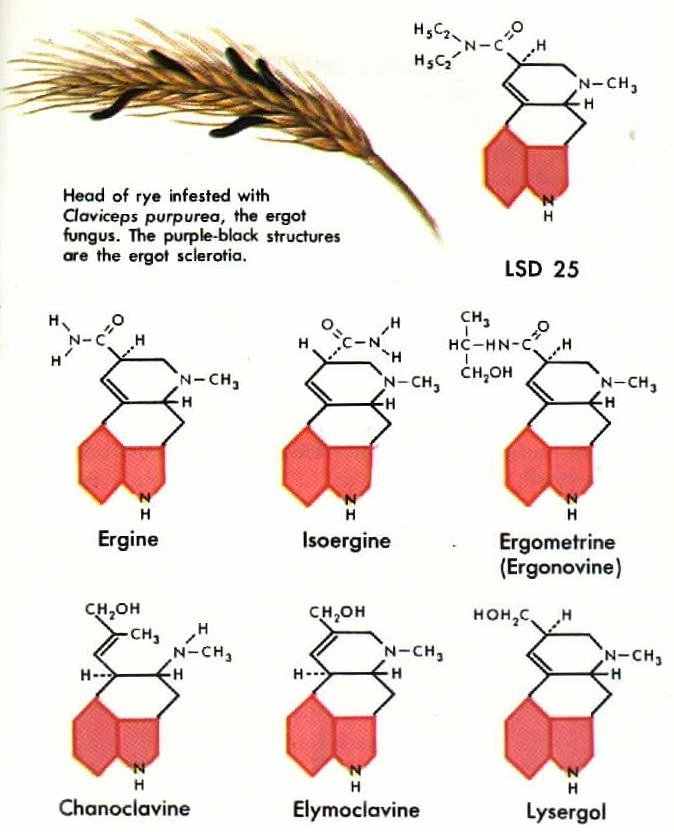
Alkaloids of the sacred Mexican morning glorys,
showing their chemical relationship to LSD.
MANY HORTICULTURAL VARIETIES of Ipomoea violacea, including the popular ornaments Heavenly Blue, Pearly Gates, Flying Saucers, Blue Stars, and Wedding Bells, as well as other varieties of Ipomoea, contain hallucinogenic constituents. Other genera, notably Argyreia and Stictocardia, also contain these substances. The Hawaiian wood rose (A. nervosa), for example, has been found to be highly intoxicating. Seeds of I. carnea, which are known to possess biodynamic constituents, are said to be used as hallucinogens in Ecuadorian folk medicine. In fact, hallucinogenic compounds are so prevalent in this family, both geographically and botanically, that it is difficult to explain why the morning glories have not been more widely employed as narcotics by primitive societies. Or have they?
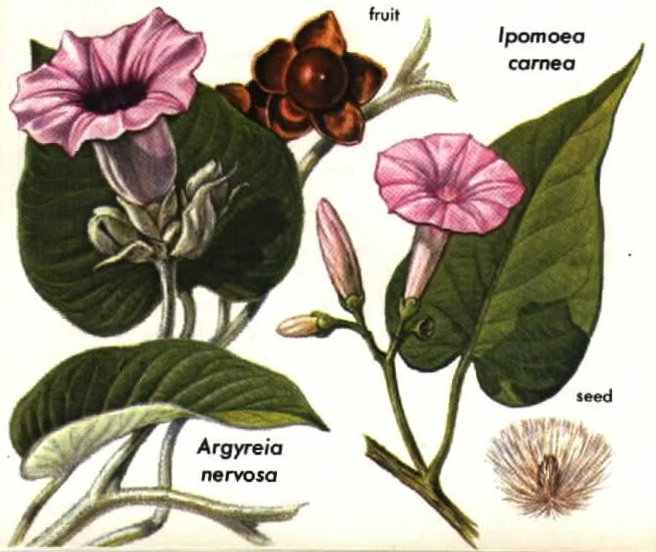
HOJAS DE LA PASTORA (Salvia divinorum), of Mexico, Is the only one of 700 species of Salvia known to be used as an hallucinogen. Mazatec Indians of Oaxaca employ the leaves as a divinotory narcotic, hence divinorum ("of the diviners"). The Mazatecs call the plant hojas de la Pastora in Spanish and shka-Pastora in their native tongue, both names meaning "leaves of the Shepherdess." The leaves are chewed fresh, or the plonts are ground on a metote, then diluted with water and filtered for drinking.
The plant is not known in the wild and rarely, if ever, develops from seed. The Mazatecs plant this mint vegetatively in remote mountain ravines, and most families use it as a drug when the sacred mushrooms (p. 58) or morning glory seeds (p. 128) are scarce. It is commonly believed to be the hallucinogenic pipilzintzintli of the ancient Aztecs.
Ingesting leaves of the plant has been found experimentally to induce an intoxication similar to that of the sacred mushrooms but less striking and of shorter duration. It is characterized by three-dimensional colored designs in kaleidoscopic motion. Chemical studies have as yet failed to isolate any psychoactive component.
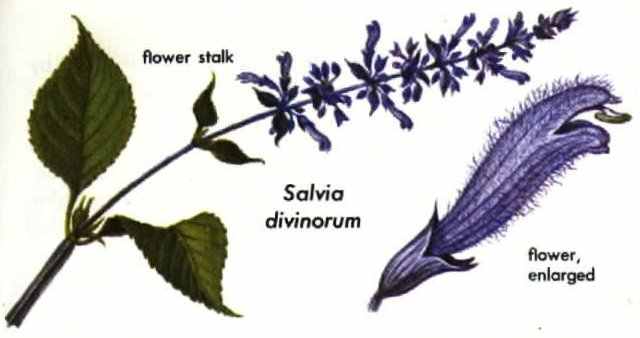
(note: the flower has white end, not purple.)
COLEUS (Coleus pumas and C. blumei) is cultivated by the Mazatecs of Oaxaca, Mexico, who reputedly employ the leaves in the some way as they use the leaves of Salvia divinorum ( see p. 137) . Indeed, the Indians recognize the family relationship between these two genera of mints, both of the family Labiatae. They refer to S. divinorum as la hembra ("the female") and to C. pumilus as el macho ("the male"). There are two forms of C. blumei, which they call el niño ("the child") and el ahijado ("the godson").
These two species are native to Asia, where they are valued in folk medicine but apparently have not been used as hallucinogens. No hallucinogenic principle hes yet been discovered in the 150 known Coleus species.

BORRACHERA (lochroma fuchsioides) is one of about two dozen species of lochroma, all native to the highlands of South America. There are suspicions and unconfirmed reports that several species of lochromo are locally taken in hallucinatory drinks, either alone or mixed with other narcotic plants, by Indians in the Sibundoy Valley of southern Colombia. Although no chemical studies have been made of lochroma, it belongs to the nightshade family, Solanaceae, well recognized for its toxic and hallucinogenic principles.
ARBOL DE LOS BRUJOS ("sorcerers' tree") or latué (Latua pubiflora) is used by the Mapuche Indian medicine men of Valdivia, Chile, to cause delirium, hallucinations, and occasionally permanent insanity. There is no cult or ritual surrounding its use, but the tree is widely feared and respected. Dosages are a closely guarded secret, and it is widely believed that a madness of any desired duration may be induced by a medicine man who knows how to measure the doses properly. The natives employ the fresh fruits.
The alkaloids hyoscyamine and scopolamine have been isolated from the fruit and are responsible for its potent effects. The only species of Latua known, the tree is confined to coastal mountains of central Chile. It belongs to the nightshade family, Solanaceae.
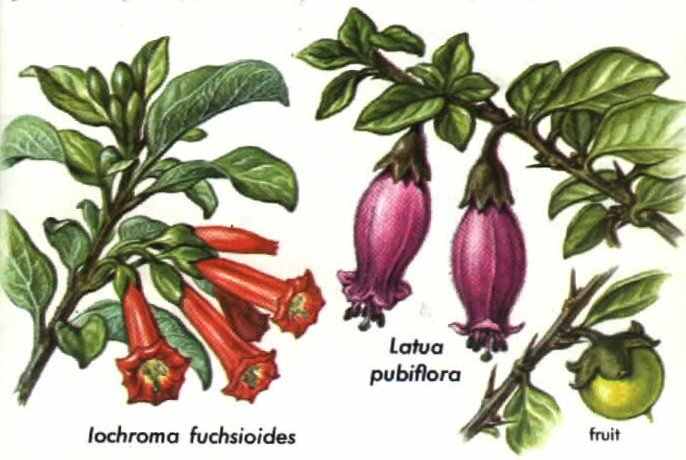
CHIRIC-CASPI and CHIRIC SANANGO (Brunfelsia) are the most common of the native names for several species of shrubs that appear to have been important hallucinogens among some South American Indian tribes. The use of the name borrachero, which means " intoxicator," indicates that the natives of Colombia, Ecuador, and Peru recognize the shrub's narcotic properties, and the special care taken in its cultivation seems to suggest a former religious or magic place in tribal life. Recently, real evidence has pointed to the use of several species of Brunfelsia either as the source of an hallucinogenic drink, as among the Kachinaua of Brazil, or as an additive to other hallucinogenic drinks, as among the Jívaro and Kofán Indians of Ecuador.
